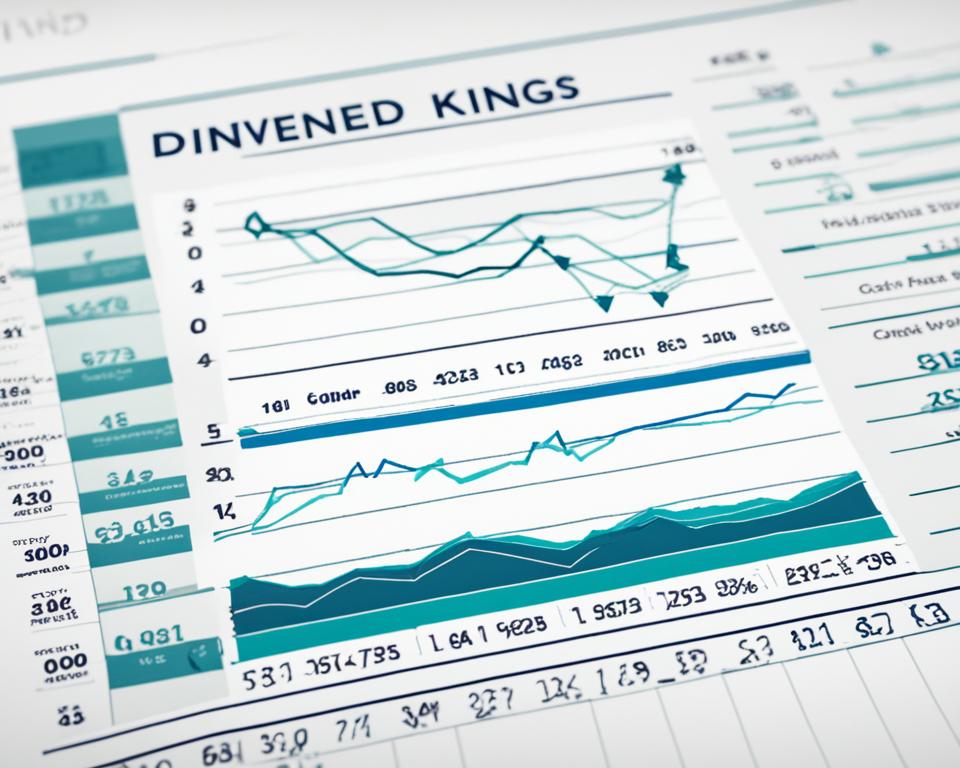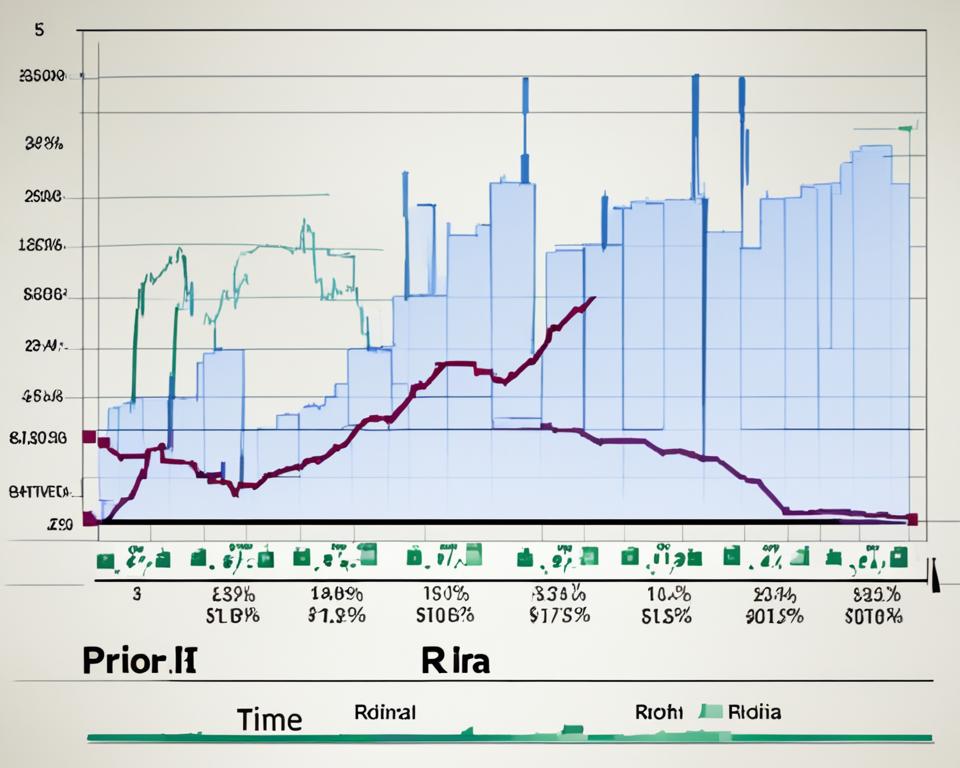With a reputation for consistent and growing dividend payouts, dividend aristocrats provide a reliable blend of stable income and strong financial health. As part of the S&P 500 index, these companies have ensured increased dividends for at least 25 years, demonstrating their financial reliability. However, the attraction of these stocks can be a double-edged sword. While the regular income they provide can be a reassuring source of stability, they may not present substantial capital gains and carry the burden of dividend taxes. It’s imperative for potential investors to weigh the pros and cons of investing in dividend aristocrats and understand the trade-off between high-yield dividends and significant stock appreciation.
Key Takeaways
- Dividend aristocrats are renowned for their consistent and growing dividend payouts, making them a signal of financial robustness.
- These prominent members of the S&P 500 index have increased their dividends for at least 25 consecutive years, illustrating their reliability.
- While they provide regular income, dividend aristocrats may offer limited capital gains, presenting a potential trade-off for investors.
- The dividends from these stocks can be subject to taxation, which should factor into an investor’s decision-making process.
- An understanding of the pros and cons of investing in dividend aristocrats is crucial for those considering their dividend aristocrats investing benefits.
Understanding the Dividend Aristocrat Criterion
Identifying a real Dividend Aristocrat involves delving into specific parameters that outline their unique investing potential. These criteria not only foster investor confidence but further fortify the firm’s reputation as a consistent income provider. Key factors include their inclusion in the S&P 500 and an unbroken record of rising dividends.
S&P 500 Inclusion and Consistent Dividend Growth
To earn the esteemed title of a Dividend Aristocrat, a company needs to pass certain tests. Notably, it must be part of the prestigious S&P 500 index, which counts amongst it some of the largest and most successful companies globally. However, what truly delineates these firms from others on the index is their impressive history of dividend growth.
- Consistent Dividend Growth: Dividend Aristocrats are distinguished by their ability to consistently increase dividend payouts for a minimum of 25 consecutive years. This pattern signals to investors a steady, reliable income source, making them favourite picks for those prioritizing income generation in their investment strategies.
Market Capitalization and Liquidity Requirements
Size and liquidity also play a significant role in shaping a Dividend Aristocrat’s profile. Known for boasting large market capitalization and strong liquidity, these firms stand out as formidable players in the investment arena.
- Market Capitalization: Dividend Aristocrats command a market capitalization that frequently tops $3 billion, underscoring their significant position in the market.
- Liquidity: Aristocrat stocks are notable for their high liquidity, indicating that their shares are easily traded in the market without significantly impacting the share price. It is this ease of transacting that further boosts their appeal among investors.
In summary, understanding the Dividend Aristocrat criterion gives investors a more solid grasp of the reasons to gravitate towards these stocks. From dependable dividend growth to robust market capitalization and strong liquidity, the characteristics of these inclusion standards promote opportunities for consistent income and potential capital appreciation.
Pros and Cons of Investing in Dividend Aristocrats
Investors generally find dividend aristocrats appealing for the dual benefit they offer – reliable income and indications of strong financials. This characteristic is a result of their proven record of consistently raising dividend payouts for a notable duration, often extending over several decades. This consistency is underpinned by their robust business models and strong cash flows, which instill great confidence in these companies. It makes them attractive investment options for those who value steady income streams, often retirees and conservative investors.
However, while these stocks enable reliable income through their regular dividends, they have their limitations as well. One of the key dividend aristocrats investment risks pertains to their growth prospects. The significant cash payouts to shareholders could indicate a lack of reinvestment into the expanding business. This could thereby limit the company’s potential for future growth.
Another concern relates to the performance of the stock. When a dividend-paying stock does not appreciate in value, companies might resort to using dividends as a means to placate investors. While this might seem beneficial in the short run, it could potentially mask underlying issues that might affect the company’s long-term stability and performance. Investors must therefore stay watchful of such scenarios while undertaking their dividend aristocrats performance analysis.
Additionally, the appeal of dividends also carries tax implications. Dividend payouts are generally taxed at the individual’s income tax rate, which can rank high depending on their overall income level. This facet adds a layer of financial planning complexity and potential disadvantage to these seemingly attractive investment options.
Therefore, like all investment types, investing in dividend aristocrats requires a delicate balancing act. Prospective investors must weigh different factors including the benefits of a stable income, the potential for reduced growth due to extensive cash payouts, tax implications of dividend income, and the risks of possibly overvalued stocks. A comprehensive understanding of these factors forms a crucial part of a sound investment decision-making process.
Assessing Dividend Aristocrats Performance Analysis
In the financial landscape, measuring the performance of investment options like dividend aristocrats isn’t just about benchmarking their returns against market indexes such as the S&P 500 Index. It is equally important to factor in the risk-adjusted returns, an aspect that lays bare the true performance of these securities when the associated risks are taken into consideration.
Comparing Historical Returns to the S&P 500
Over the last decade, dividend aristocrats have proven to be a picture of consistency, hewing closely to the broader market in terms of total annual return. This alignment with the S&P 500 Index emphasizes the robustness of these dividend aristocrats. It’s a testament to their well-insulated financial health and commendable resilience amid market upheavals. Let’s take a closer look at the comparative data.
| Year | Dividend Aristocrats Annual Return | S&P 500 Index Annual Return |
|---|---|---|
| 2020 | 12.3% | 16.3% |
| 2019 | 30.6% | 31.2% |
| 2018 | -3.3% | -4.4% |
| 2017 | 18.1% | 21.7% |
Risk-Adjusted Returns Considerations
Risk, as everyday investors know, is an inherent part of the investing process. Hence, taking a myopic view of returns can be misleading. To get a clearer picture of how dividend aristocrats fare, we need to consider risk-adjusted returns. By factoring in volatility and evaluating key metrics like the Sharpe ratio, we can determine how these stocks perform compared to the broader market when their associated risks are accounted for.
The less volatile a security is, the lower its risk, making it an appealing option for the risk-averse investor. This rings true for dividend aristocrats because their lower volatility, coupled with consistent returns, makes them a reliable and attractive investment option.
Why Dividend Aristocrats Offer Stable Income Streams
If you are looking for a solid and predictable investing strategy, dividend aristocrats could be the option for you. In an arena marked by economic ups and downs, these companies stand as paragons of economic resilience while also providing steady income streams, making them attractive to investors prioritizing stability. Below we discuss the central reasons, namely their role as recession-proof investments and the predictability of their dividend policies, that make dividend aristocrats a compelling option for anyone aiming for stable income.
Recession-Proof Investments and Steady Profits
One of the main reasons for the heightened interest in dividend aristocrats is their resilience amidst economic downturns. Their consistent profits and capacity to maintain dividend growth, even in the face of economic slumps, herald them as recession-proof investments. This is a feature of investing that speaks volumes about the company’s financial health and adds to the appealing nature of these investments.
Predictable Dividend Policies and Cash Flow Security
Additionally, another draw for investors is the predictable dividend policies of these companies. Whether the market is bullish or bearish, these companies have demonstrated commitment to their shareholders by means of stable, constant, or even escalating dividends. This regularity offers an assured and dependable income for investors, providing a soothing sense of cash flow security regardless of market volatility.
The table below depicts a comparative analysis of dividend aristocrats against more volatile investments highlighting their relative stability and predictable dividends.
| Factors | Dividend Aristocrats | Volatile Investments |
|---|---|---|
| Stability during economic downturns | Highly Stable | Less Stable |
| Dividend consistency | Very Predictable | Unpredictable |
| Income generation | Steady | Fluctuating |
To sum up, the dividend aristocrats investing benefits and their ability to provide a stable income make them desirable for investors looking for a long-term investment strategy that offers regular income and security, especially during turbulent times. However, despite these advantages, the decision to invest in dividend aristocrats should also factor in the investor’s specific income requirements, risk tolerance, and overall financial goals.
Investing in Dividend Aristocrats Comparison to Growth Stocks
Investment strategies are diverse, offering myriad financial paths to choose from. One such path is the classic dilemma between investing in dividend aristocrats and growth stocks. Both carry their own sets of pros and cons, and the best option often depends on the individual investor’s financial goals and risk tolerance.
Dividend aristocrats – companies known for their consistent and increasing dividends – are revered for their financial robustness and ability to provide a steady source of passive income. With their predictable and regularly increasing dividends, they present a prime choice for investors craving stability and financial security over the long term.
In stark contrast, growth stocks, typically devoid of dividend payments, offer a completely different risk-reward ratio. The potential for substantial price appreciation is the key drawing card of growth stocks. Investors who place a higher importance on capital gains and can stomach a higher level of risk might opt for growth stocks over dividend-paying alternatives.
Mainly, these companies focus on reinvesting profits back into expansion, a strategy aimed at boosting future growth and ultimately leading to increased stock prices. However, the lack of dividends means that investors have to wait for the realization of capital gains to earn profits. Unlike dividend aristocrats, they do not provide immediate income.
In conclusion, choosing between dividend aristocrats and growth stocks requires an assessment of one’s investment goals, risk tolerance, and patience. For those seeking a steady cash influx, dividend aristocrats might be a more suitable bet, while risk-takers aiming for considerable capital appreciation may find growth stocks more aligned with their financial vision.
The Longevity Factor: Dividend Kings versus Dividend Aristocrats
Delving further into the protracted viability and financial strength of dividend-paying companies, investors find themselves weighing the benefits of dividend aristocrats vs dividend kings as long-term investment options. While tyros in the investment landscape may perceive these terms as interchangeable, seasoned investors appreciate the nuances distinguishing the two, understanding how these subtle variations can influence their investment approach.
The Distinction of 50-Year Consistent Dividend Increases
Perched atop the dividend hierarchy, the dominance of Dividend Kings is fueled by their unprecedented record of increasing dividends for 50 consecutive years or more. This achievement extends beyond mere financial dexterity, symbolizing a half-century of steadfast commitment to shareholders, proficient management, and a resilient business model capable of withstanding fluctuating market cycles and exigent economic conditions.
Identifying Dividend Kings Among the Aristocrats
A deep dive into the investment landscape about dividend aristocrats and dividend kings would reveal that all dividend kings are, by default, dividend aristocrats, but not vice versa. The disparity arises due to the stringent criterion of 50-year dividend increments that each Dividend King adheres to, a task that not every aristocrat can meet. Thus, while the aristocrats’ club is already limited and distinguished, the kings’ fraternity is even more elite.

This longevity factor plays a significant role for investors seeking out potentially safer, long-term investment options. The merits of such investments are grounded in their impressive track record, substantial returns, and reduced vulnerability to market turbulence or economic adversity. Hence, investors inclining towards tenacity and solid performance may find themselves gravitating towards Dividend Kings as the embodiment of long-term, unwavering dividend reliability.
Dividend Aristocrats Portfolio Strategy for Different Investors
Investors after regular, steady income often regard dividend aristocrats as enticing investments. These companies, known for their consistent performance and habit of delivering reliable dividends, present an appealing cornerstone for a dividend-focused investment portfolio. However, like many investment strategies, the application of dividend aristocrats within a portfolio depends significantly on individual investor goals, risk tolerance, and financial circumstances.
Building a Dividend-Focused Portfolio
For those predominantly seeking a stable income source, constructing a portfolio heavily weighted with dividend aristocrats can be a strategic move. It leverages the proven longevity and reliable dividend growth of these companies, translating into regular income for the investor. This strategy is particularly suitable for conservative investors with a longer investment horizon and those approaching or in retirement who value the steady stream of payout income.
Appropriate Allocation in Your Overall Investment Portfolio
Dividend aristocrats, while promising, should not be the lone ingredient in an investor’s portfolio recipe. Younger investors, or those with a higher risk tolerance, can balance their portfolio by complementing dividend aristocrats with growth stocks. While these stocks might not offer the comfort of regular dividends, they boast substantial potential for capital appreciation over time. Striking the right balance is key, keeping in mind that diversification can protect from risks inherent in investing solely either in dividend aristocrats or growth stocks.
Risks Associated with Dividend Aristocrat Investments
Despite their recognized prestige, investing in dividend aristocrats is not devoid of risks. Experts keen to adopt a dividend investment strategy should consider potential challenges before making savvy investment decisions.
One of the most plausible risks of investing in dividend aristocrats is the limitation on growth opportunities. Dividend aristocrats, while remarkably consistent in generating income, may not provide high capital gains compared to other equities. Often, these companies prefer to distribute profits among shareholders rather than reinvest in business growth, which could circumscribe their expansion potential.
Furthermore, during turbulent financial times, dividend aristocrats might face the unfortunate need to cut down their dividend payouts. Being reliant on dividends for regular income might pose significant risks during economic downturns, as no company, however steadfast, is immune to extreme market conditions. Thus, this susceptibility to dividends being slashed is another pertinent risk to consider.
Investors need to vigilantly decipher between truly profitable dividend aristocrats and possible “dividend traps”. Some stocks might offer extremely high yields only to disappoint later with unsustainable returns. Hence, deep research and due diligence are incumbent upon investors as part of their dividend investment strategy to steer clear of these potential pitfalls.
Decoding these risks effectively will provide a more nuanced picture of the investment landscape. To aid in such assessments, the following table underlines significant considerations for investors contemplating an investment in dividend aristocrats.
| Inherent Risks | Descriptions | Strategies to Manage |
|---|---|---|
| Constrained Growth Opportunities | Profits are distributed among shareholders, limiting reinvestment in business expansion | Look for a balanced portfolio that includes high-growth, non-dividend-paying stocks |
| Dividend Cuts | During economic downturns, companies might cut down their dividend payouts | Dividend diversification across various sectors and industries to curb overall risk |
| Dividend Traps | Some stocks might offer high yields, only to disappoint later with unsustainable returns | Conduct thorough research and due diligence before investing |
In conclusion, while embracing a dividend investment strategy might seem lucrative due to regular cash inflow, investors need to be mindful of the underlying risks of investing in dividend aristocrats. Detailed investigation into these adversities will ensure informed and safer investment decisions, contributing to a robust, well-balanced portfolio.
Real-World Examples of Successful Dividend Aristocrats
For those considering investing in dividend aristocrats, there’s nothing quite as enlightening as reviewing real-life examples of successful implementation of the strategy. Indeed, these examples anchor abstract financial theory in the real-world market, allowing us to glean insights from business giants who have weathered economic peaks and troughs while maintaining consistent dividend growth.
Examples of such formidable companies include stalwarts like Walgreens Boots Alliance, Exxon Mobil, and 3M, all of which have portrayed dividend aristocrat characteristics over considerable periods. Now, let’s delve deeper into their impressive trajectories.
Case Studies of Companies with Longstanding Dividend Growth
When it comes to reliable dividend growth, Walgreens Boots Alliance, Exxon Mobil, and 3M stand tall as perfect examples of success. Their dividend growth revelations are telling of their robust financial capabilities, benefiting their standing in the shareholder spectrum.
| Company | Years of Dividend Growth | Current Dividend Yield |
|---|---|---|
| Walgreens Boots Alliance | 45 | 3.76% |
| Exxon Mobil | 38 | 6.11% |
| 3M | 62 | 3.06% |
Impact of Economic Cycles on Dividend Aristocracy
Another key feature of dividend aristocrats involves their resilience during economic downturns. Despite economic adversities, these companies, aided by their vast business machinery and financially prudent decisions, have managed to sustain, and in many instances, increase their dividends. This practice, demonstrating their unwavering commitment to shareholders, reflects positively on their long-standing and robust business models.
This pattern of stable dividend growth irrespective of market conditions or economic cycles puts dividend aristocrat companies in a league of their own, highlighting the benefits and potential stability offered when investing in dividend aristocrats.
As can be seen, the proof of the pudding truly lies in the taste. When it comes to the investing in dividend aristocrats comparison, nothing sums it up better than the evidence provided by real-world dividend aristocrat examples.

Conclusion
When stepping into the world of investment, weighing the pros and cons of investing in dividend aristocrats is a crucial task. Dividend aristocrats garner attention for their distinctive offering of a steady income stream and financial stability. Their attribute of consistently raising dividends has made them a staple in the diversified investment strategy of many astute investors. This is particularly true for those who seek regular income and those who prefer safer harbors in times of stormy market volatility.
Nevertheless, investing in these stalwarts does not come without its caveats. Despite providing regular dividends, these stocks may not deliver the sky-rocketing growth often seen with non-dividend-paying equities. Investors must strike the perfect balance between a hunger for regular dividends and an appetite for capital gains.
In the decision of including dividend aristocrats in a financial portfolio, a well-rounded examination of financial goals and market conditions is paramount. Such a judicious analysis can serve to mitigate risks while simultaneously capitalizing on the unique potential of dividend aristocrats. Remember, each investor’s needs are unique, and what serves one might not serve another. So, Here’s to making informed and successful investment choices!
FAQ
What are the key advantages and drawbacks of investing in dividend aristocrats?
Dividend aristocrats are reputed for consistent and growing dividend payouts, signifying business stability and financial strength. Investors can rely on these stocks for regular income, particularly during economic turmoil. However, these benefits may be offset by the potential lack of significant capital gains commonly seen in non-dividend-paying stocks, the burden of dividend taxes, and the risk of complacency in businesses that use dividends to appease shareholders rather than reinvesting in their operations.
What are the qualifications to be classified as a dividend aristocrat?
To be classified as a dividend aristocrat, a company must be part of the S&P 500 index and consistently increase its dividends for a minimum of 25 years. Beyond these requirements, dividend aristocrats usually have a market capitalization exceeding $3 billion, ensuring significant liquidity and ease of trading.
How do dividend aristocrats perform compared to the broader market?
Over the past decade, dividend aristocrats have held their own against the broader market, providing nearly equivalent total annual return as the S&P 500 Index. While they have lower volatility, which could be appealing to risk-averse investors, it’s crucial to consider their risk-adjusted returns, using metrics like the Sharpe ratio for a true comparison with the overall market.
How do dividend aristocrats compare to growth stocks?
While dividend aristocrats provide dependable dividends hinting at strong finances, they may not deliver the potentially steep price appreciation seen in growth stocks, which typically don’t distribute dividends and instead reinvest profits into the business for expansion. Hence, the decision between investing in dividend aristocrats and growth stocks hinges on the investor’s preferences for immediate return vs long-term gains.
What’s the difference between dividend aristocrats and dividend kings?
Dividend kings are a subset of dividend aristocrats that have consistently increased their dividends for over 50 years instead of the 25-year minimum of aristocrats. This distinguishes them as prime examples of steadfast performance and robust financial health.
How should I incorporate dividend aristocrats in my investment portfolio?
Depending on their financial situation and goals, investors might want to develop a dividend-focused portfolio made up entirely of aristocrats, or balance these stocks with growth stocks for variety and potential higher long-term returns. The proportion of dividend aristocrats in a portfolio can be adjusted as per the investor’s risk tolerance, investment horizon, and income needs.
What are the risks involved in investing in dividend aristocrats?
Though dividend aristocrats symbolize stability, they carry risks such as a possible dearth of growth opportunities and dividend reductions during rough financial conditions. It’s advised to review the company’s dividend payout ratio to ensure the sustainability of dividends and stay wary of high-yielding stocks that could turn out to be “dividend traps”.
Can you cite real-world examples of successful dividend aristocrats?
Companies like Walgreens Boots Alliance, Exxon Mobil and 3M have a proven record of consistent dividend increases, and have managed to maintain or even raise dividends through various economic cycles. Their case studies can help investors grasp the sustainable practices pivotal for earning a place among the coveted ranks of dividend aristocrats.












